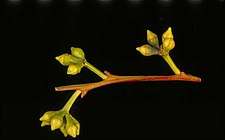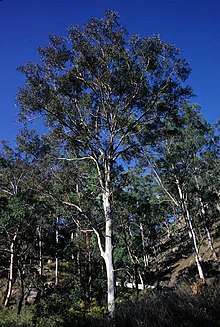Eucalyptus major
Eucalyptus major, commonly known as grey gum,[2] is a species of tree that is endemic to a small area near the New South Wales - Queensland border. It has smooth greyish bark, lance-shaped adult leaves, flower buds in groups of seven and conical to cup-shaped fruit.

| Grey gum | |
|---|---|
 | |
| Eucalyptus major near Clifton | |
| Scientific classification | |
| Kingdom: | Plantae |
| Clade: | Tracheophytes |
| Clade: | Angiosperms |
| Clade: | Eudicots |
| Clade: | Rosids |
| Order: | Myrtales |
| Family: | Myrtaceae |
| Genus: | Eucalyptus |
| Species: | E. major |
| Binomial name | |
| Eucalyptus major | |
| Synonyms[1] | |
|
Eucalyptus propinqua var. major Maiden | |
Description
Eucalyptus major is a tree that typically grows to a height of 20 m (66 ft) and forms a lignotuber. It has smooth, blotched greyish bark that is shed in large plates or flakes. Young plants and coppice regrowth have egg-shaped leaves that are a lighter shade of green on the lower side, 75–100 mm (3.0–3.9 in) long and 25–40 mm (0.98–1.57 in) wide. Adult leaves are lance-shaped to curved, dark green on the upper surface, paler below, 90–200 mm (3.5–7.9 in) long and 20–40 mm (0.79–1.57 in) wide, tapering to a petiole 15–30 mm (0.59–1.18 in) long. The flower buds are arranged in leaf axils in groups of seven on a flattened, unbranched peduncle 7–15 mm (0.28–0.59 in) long, the individual buds sessile or a pedicels up to 5 mm (0.20 in) long. Mature buds are oval to diamond-shaped, 6–9 mm (0.24–0.35 in) long and 4–5 mm (0.16–0.20 in) wide with a conical operculum. Flowering has been recorded in November and the flowers are white. The fruit is a woody, conical to cup-shaped capsule 3–5 mm (0.12–0.20 in) long and 4–8 mm (0.16–0.31 in) wide with the valves protruding prominently above the rim of the fruit.[2][3][4]
Taxonomy and naming
This eucalypt was first formally described in 1923 by Joseph Maiden who gave it the name Eucalyptus propinqua var. major and published the description in his book A Critical Revision of the Genus Eucalyptus.[5][6] In 1934, William Blakely raised the variety to species status as Eucalyptus major, publishing the change in his book A Key to the Eucalypts.[7] The specific epithet (major) is a Latin word meaning "greater".[8]
Distribution and habitat
The grey gum grows in tall forest in coastal areas and nearby hills in south-eastern Queensland, south from the Blackdown Tableland to far northern New South Wales.[2][3][4]
Conservation status
This eucalypt is classified as "least concern" in Queensland under the Queensland Government Nature Conservation Act 1992.[9]
References
- "Eucalyptus major". Australian Plant Census. Retrieved 23 September 2019.
- K.Hill. "New South Wales Flora Online: Eucalyptus major". Royal Botanic Gardens & Domain Trust, Sydney, Australia.
- "Eucalyptus major". Euclid: Centre for Australian National Biodiversity Research. Retrieved 1 June 2020.
- Chippendale, George M. "Eucalyptus major". Australian Biological Resources Study, Department of the Environment and Energy, Canberra. Retrieved 23 September 2019.
- "Eucalyptus propinqua var. major". APNI. Retrieved 23 September 2019.
- Maiden, Joseph (1923). A Critical Revision of the Genus Eucalyptus. Sydney: New South Wales Government Printer. p. 504. Retrieved 23 September 2019.
- "Eucalyptus major". APNI. Retrieved 23 September 2019.
- Short, Emma; George, Alex (2013). A Primer of Botanical Latin with Vocabulary. Cambridge, U.K.: Cambridge University Press. p. 207. ISBN 9781107693753.
- "Mountain grey gum - Eucalyptus major". Queensland Government Department of Environment and Science. Retrieved 23 September 2019.